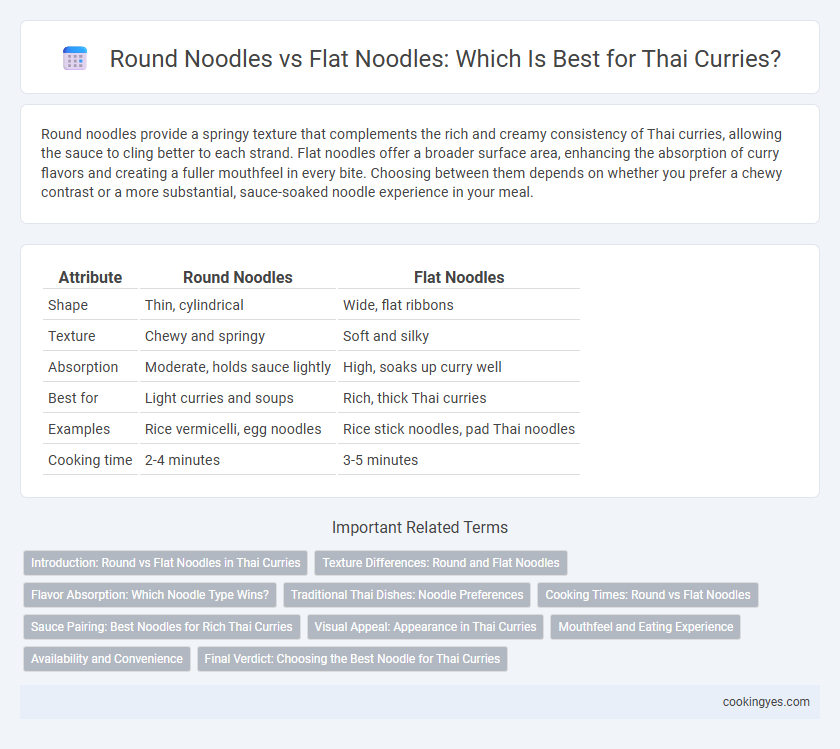Round noodles provide a springy texture that complements the rich and creamy consistency of Thai curries, allowing the sauce to cling better to each strand. Flat noodles offer a broader surface area, enhancing the absorption of curry flavors and creating a fuller mouthfeel in every bite. Choosing between them depends on whether you prefer a chewy contrast or a more substantial, sauce-soaked noodle experience in your meal.
Table of Comparison
| Attribute | Round Noodles | Flat Noodles |
|---|---|---|
| Shape | Thin, cylindrical | Wide, flat ribbons |
| Texture | Chewy and springy | Soft and silky |
| Absorption | Moderate, holds sauce lightly | High, soaks up curry well |
| Best for | Light curries and soups | Rich, thick Thai curries |
| Examples | Rice vermicelli, egg noodles | Rice stick noodles, pad Thai noodles |
| Cooking time | 2-4 minutes | 3-5 minutes |
Introduction: Round vs Flat Noodles in Thai Curries
Round noodles, such as rice vermicelli and egg noodles, absorb Thai curry sauces differently than flat noodles like wide rice noodles or pad see ew noodles. The thickness and surface area of flat noodles enhance their ability to hold rich, creamy curries, making them ideal for dishes like Panang or Massaman curry. In contrast, round noodles provide a lighter texture and better integration within soup-based or thinner curry preparations like Thai coconut curry soups.
Texture Differences: Round and Flat Noodles
Round noodles, such as rice vermicelli, offer a springy and chewy texture that complements the rich, creamy consistency of Thai curries, allowing the sauce to cling evenly around each strand for enhanced flavor absorption. Flat noodles, like kuay teow, provide a broader surface area, resulting in a silkier and smoother mouthfeel that soaks up curry sauces thoroughly, creating a harmonious blend with the curry's bold spices. The choice between round and flat noodles significantly influences the overall eating experience by balancing texture contrasts and sauce retention in traditional Thai curry dishes.
Flavor Absorption: Which Noodle Type Wins?
Round noodles, such as rice vermicelli and egg noodles, excel in flavor absorption due to their tubular shape that traps Thai curry sauces effectively, intensifying each bite. Flat noodles like pad see ew or wide rice noodles provide a broader surface area, which allows the curry to cling and coat the noodles evenly, enhancing taste distribution. For maximum curry flavor infusion, round noodles generally outperform flat noodles by capturing sauce within their structure, while flat noodles offer a balanced yet less concentrated flavor experience.
Traditional Thai Dishes: Noodle Preferences
Round noodles, such as kuay teow sen lek, are preferred in Thai curries like kuay teow nuea toon for their ability to absorb rich, spicy coconut-based sauces. Flat noodles, including sen yai, are commonly used in dishes like pad see ew but are less suitable for curry dishes due to their broader surface that can dilute intense flavors. Traditional Thai cuisine emphasizes the texture and sauce absorption when selecting round noodles for curry preparations, maintaining authentic taste and mouthfeel.
Cooking Times: Round vs Flat Noodles
Round noodles typically cook faster than flat noodles due to their smaller surface area and uniform thickness. Flat noodles, especially wider varieties, require longer cooking times to achieve the desired tenderness and absorb the rich flavors of Thai curries effectively. Selecting the appropriate noodle shape can influence both the texture and integration of the curry sauce, enhancing the overall dining experience.
Sauce Pairing: Best Noodles for Rich Thai Curries
Round noodles like rice vermicelli excel at absorbing rich, aromatic Thai curry sauces due to their thin, porous texture, enhancing every bite with balanced flavor. Flat noodles, such as wide rice noodles, provide a chewier consistency that holds thick, creamy curries like Massaman or Panang well, delivering a satisfying mouthfeel. Choosing round noodles ensures lighter, sauce-infused dishes, whereas flat noodles complement heavier, sauce-laden curries by maintaining structure and richness.
Visual Appeal: Appearance in Thai Curries
Round noodles in Thai curries offer a delicate, uniform appearance that absorbs rich sauces evenly, enhancing the dish's vibrant colors and textures. Flat noodles provide a broad surface that visually showcases the creamy curry, creating an appealing contrast between the noodles and the curry sauce. Both types contribute distinct visual dynamics, with round noodles emphasizing smoothness and flat noodles highlighting the dish's thickness and color depth.
Mouthfeel and Eating Experience
Round noodles, such as rice vermicelli, offer a delicate, smooth texture that absorbs Thai curry flavors evenly, creating a silky mouthfeel with each bite. Flat noodles, like wide rice noodles, provide a chewier and more substantial eating experience, enhancing the curry's richness by holding thicker sauce layers on their broader surface. Choosing between round and flat noodles directly influences the balance between tenderness and texture in traditional Thai curry dishes.
Availability and Convenience
Round noodles like rice vermicelli are widely available in Asian markets and supermarkets, making them a convenient choice for Thai curries. Flat noodles such as wide rice noodles are also common but may require more careful selection to match curry textures. Both types offer quick preparation options, yet round noodles typically provide greater accessibility for home cooks.
Final Verdict: Choosing the Best Noodle for Thai Curries
Round noodles, such as rice vermicelli or thin egg noodles, absorb Thai curry sauces effectively, offering a balanced blend of texture and flavor. Flat noodles like wide rice noodles hold thicker curries well, providing a chewy bite that complements the richness of dishes like Panang or Massaman curry. For authentic Thai curry experiences, flat noodles often emerge as the preferred choice due to their superior sauce retention and mouthfeel.
Round noodles vs flat noodles for Thai curries Infographic

 cookingyes.com
cookingyes.com